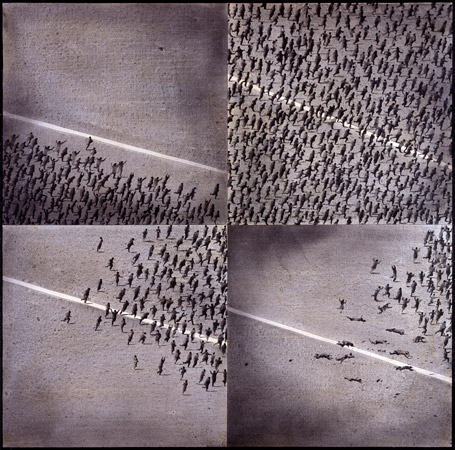Genovés, The Archaeology Of Panic
Pierre Cabanne, Enero 1991
What is this town, this country that we can see from the sky, which looks petrified, like a dead city; half in ruins? There is a kind of dust or a fog made up of ashes that covers everything and which is cut through by the glare from blinding lights in the pale light of the day. Frightened men run around in all directions, terrified and followed by those powerful, sweeping light beams. When they join up they are also chased mercilessly. The scare is over and they seem at peace again. On the beach or on the sand, in a dark crucible, overflowing with people, the powerful parallel beams of light sweep over them again like the bars of a prison.Read less
Genovés’ paintings don’t describe precise scenes but are like abstract or even unnameable snapshots of violent life. They are flashes that are pleasing to the eye, not only because of the brutal contrasts between the shadow and the light that are accentuated by the unusual cinematographic setting, which recalls an atmosphere of that archaeology of panic. In 1969 Stuart cooper made the film “A test of violence” using scenes of aggression and repression taken from Genovés’ paintings.

These paintings are like theatres of memory. The painter experienced, first hand, as a child the sudden irruptions of the “forces of order” caused by sudden flights. He saw towns bombed and deserted, cultures destroyed. The violence of the fascist dictatorship has crushed what was familiar and day-to-day. Anonymous places exist where silence reigns and only shadows remain. Deathly silence.

In some paintings and gouaches the sand has been replaced by ash. The ruins evoke an ancient topography as if seen from an aeroplane. Will man come back? Is he hidden away where we can’t see him? In his hideaway, washed by light, the traces of the shadows get longer. There are other signs of flight…it could be said of the Spanish paintings that sometimes the light of the background and the paler colours are absorbed by the darkness of the painting in the night.
This is Genovés’ first solo show in Paris. From 1961 he has been one of Spain’s leaders of the “new figuration”. He is a member of “Grupo Hondo” who react to the crisis in the art world caused by “informal” art and who support the need for a social and political conscience in art. He was also a member of “Cronica de la Realidad” (Real life Chronicle) from 1964 – 1965, which arose from the invasion of pop art. Genovés along with contemporary Spanish art groups such as “Equipo Cronico”, “Equipo Realidad” and individuals such as Rafael Canogar and Arroyo and in spite of all of their differences regarding language and spirit were all involved in the search for a modern identity for Spain.
The painter has works in many important museums in New York, Barcelona, Madrid and Cuenca. He has exhibited many times both in groups and individually in the Paris Museum of Modern Art. He has been invited to biennials in Venice and in Sao Paolo. In France he took part in the Paris biennial in 1961; in the exhibition “The Figurative Narrative in Contemporary Art” in 1965; in “Living Art 1965 -1968” in the Maeght Foundation and in the Menton biennial in 1975.
Through Genovés’ later works we can see that his painting speaks directly to man. It denounces the aggressions he suffers. Man is never alone but always caught up in a collective storm of helplessness and anguish. His language has resonances of the tragic backdrop of “España negra” (dark Spain), of its liberation and its fatality. His work has a visionary presence to it that is not only modern it is perennial.
